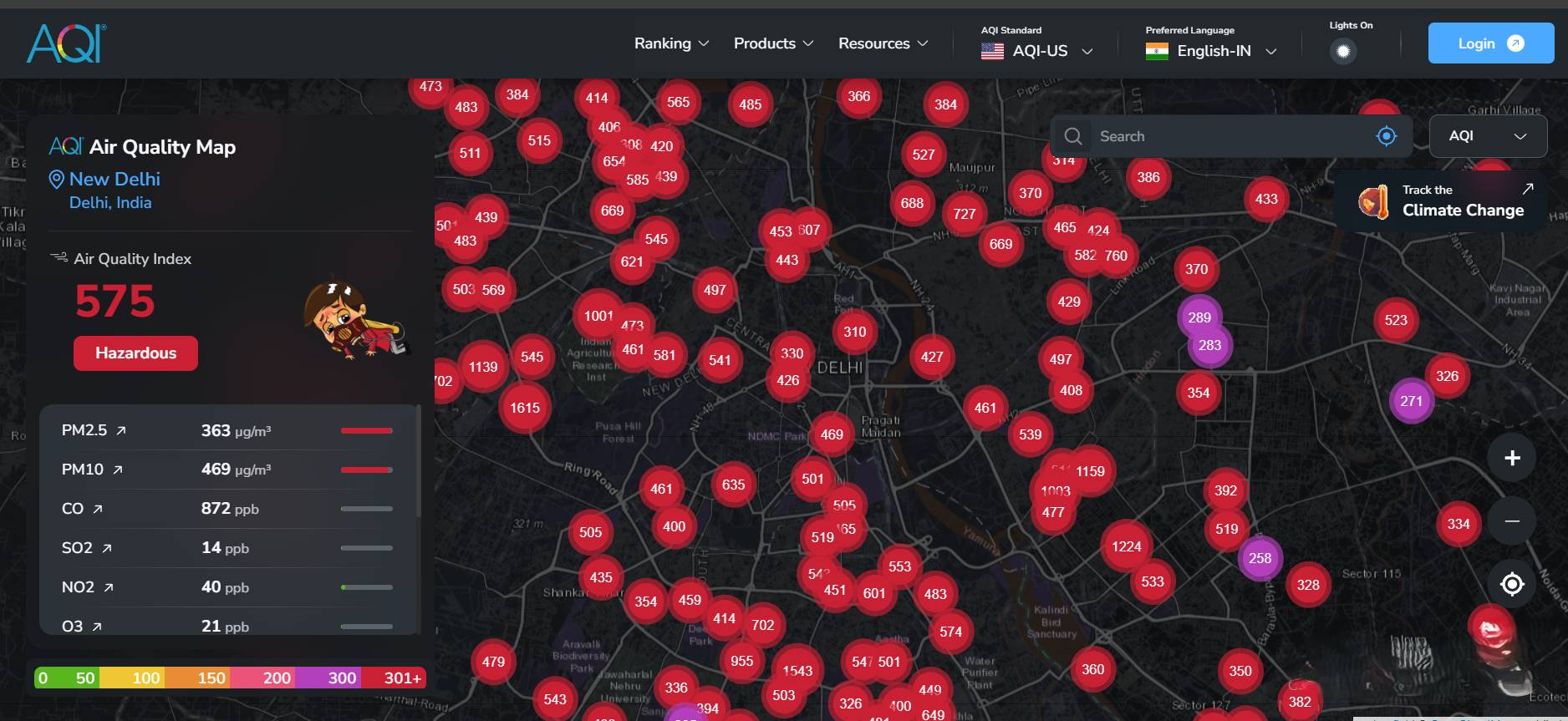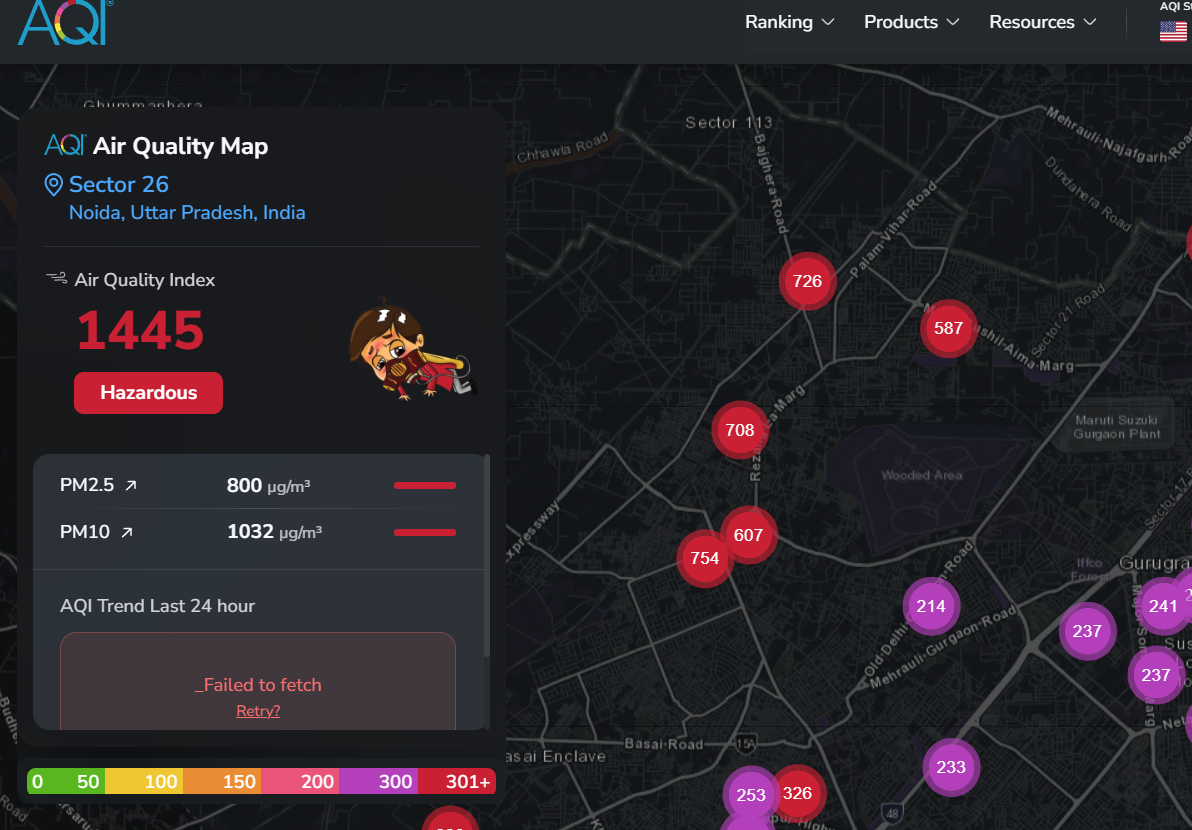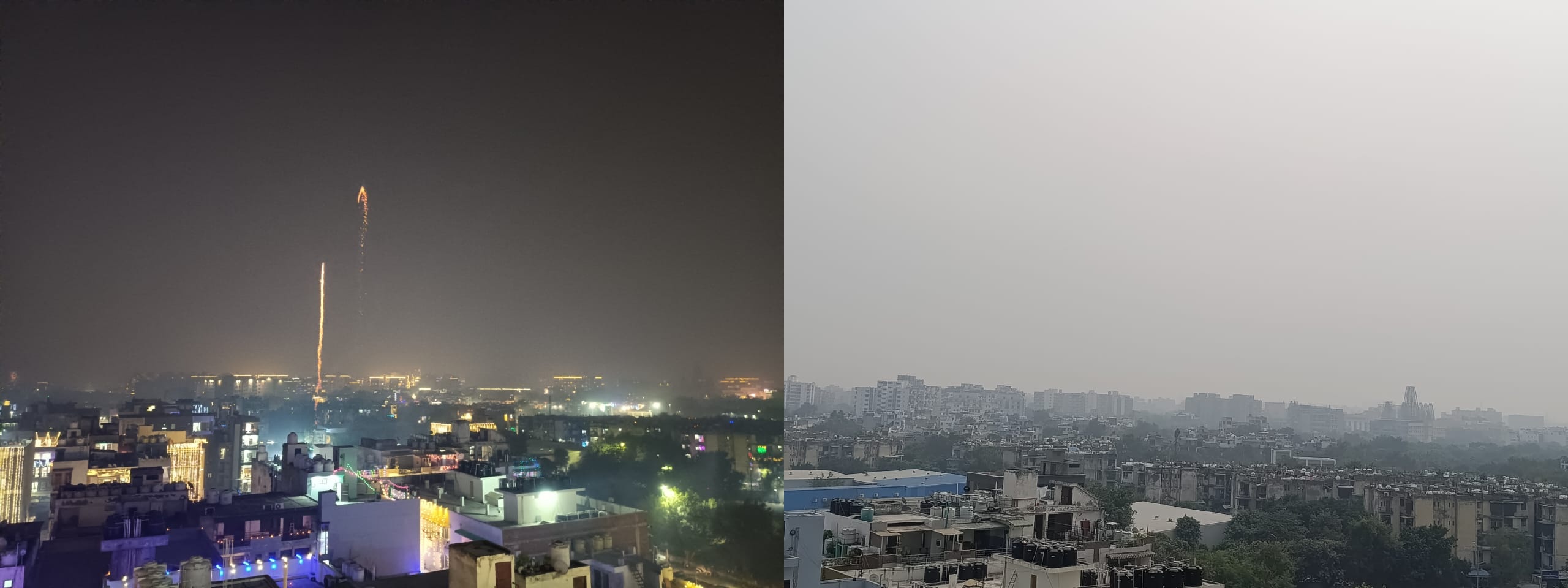07 November 2025


The Supreme Court’s decision to allow ‘green’ firecrackers in Delhi, with its concomitant enforcement challenges and poor reflection of ground realities, had not just enabled the inflow of illegal firecrackers but also their unchecked bursting across the city and NCR. The outcome is the AQI average crossing the 500 mark and over 1500 in the surge spots, even as allegations fly over government-run monitoring stations being ‘nonfunctional’ during peak hours. The Polity provides this Ground Report, citing live data from non-governmental entities, and assesses the political and judicial imprints behind the toxic fallout.
Home and text page images are AI-generated and representational
What does it speak of a society that goes on a self-harming mode, be it for cultural, religious, or any other reasons, and yet is in denial of its ground realities?
Currently, the condition of Delhi and the National Capital Region (NCR) is such that a Diwali, expected to be celebrated with the conscientious use of ‘green’ firecrackers, ended up with record spikes on the Air Quality Index (AQI). The shocking part, however, was that the ruling dispensation and the governing apparatus had sought to, allegedly, manipulate the live AQI monitoring process with an apparent view to score political gains by ‘managing,’ if not distorting, the narrative and public discourse.

Image: Delhi shown as averaging at 575 in the AQI.in website at 1 AM on 21st October 2025
To anyone who experienced the Diwali celebrations of 20th October 2025 in Delhi and NCR, it will be evident whether and how ‘green’ it was, what the ambient air quality was in the peak hours when firecrackers exploded around the city without any restrictions, whether all those firecrackers were indeed ‘green’ as instructed by the Supreme Court, whether the AQI monitoring systems of the Central Pollution Control Board (CPCB) and Delhi Pollution Control Committee (DPCC) were non-functional during these peak hours, and whether the state and central governments sought to portray the ambient air as being within safe limits, and if so, what was the purpose of such a self-defeating approach?
On Diwali eve, there were media reports of illegal crackers (that do not meet the ‘green stipulation) already flooding the city and NCR markets in extensive numbers and being sold in flagrant violation of the SC order. The question is moot whether this will happen without the silent consent of the authorities and governmental agencies – a fact that the apex court itself should not have been oblivious to.
Politics of AQI data
Around midnight of Diwali, a Google search revealed that the CPCB monitoring was not appearing live. Various reports, which could not be independently confirmed by The Polity, indicated that the CPCB’s tracking of PM2.5 and PM10 for GRAP (Graded Response Action Plan) data was unavailable from 7 PM on the Diwali evening to 6 AM on 21st October.
Sources authoritatively aware of the ambient air monitoring system told The Polity, on condition of anonymity, that the AQI data remained unchanged – 343 at 5 PM on 20th October and 347 at 6 AM on 21st October. Most DPCC monitoring stations in Delhi, according to these sources, reportedly showed data as missing during the critical window between 11 PM on Diwali night and 6 AM on the next morning.

Image: A reading of 1631 AQI at Nariana village in South-west Delhi on the AQI.in website at 1 AM on 21st October 2025
During the intervening night, The Polity’s Google search led it to live AQI data from other entities like AQI.in. What came out past midnight was a shocking sight of AQI spiking to record levels across Delhi and NCR, with more than readings at more than 1000 at a high number of places and beyond 1500 in a few. As the images recorded past 1 AM of 21st October shows, Chanakya Place in Central Delhi recorded a high of 1659, followed by 1629 in Nariana area of South West Delhi, Sector 13 Dwarka at 1505, and 1445 in Sector 26 Noida.

Image: A reading of 1659 at Chanakya Place in Central Delhi on the AQI.in website at 1 AM on 21st October 2025
To any political party running the state government in Delhi, controlling pollution is a sensitive issue. However, this year, the ruling Bharatiya Janata Party (BJP) approached the Supreme Court seeking permission for ‘green crackers.’ The BJP was known to have consistently vouched for bursting firecrackers during Diwali as opposed to its predecessor, the Aam Aadmi Party’s (AAP) decision to ban the same in the light of pollution during the festival season, which, most often, coincided with the farm fires emanating from the North Western states.

Image: A reading of 1505 recorded in Sector 13 Dwarka in South-west Delhi on the AQI.in website at 1 AM on 21st October 2025
Since the great smog of 2016, pollution has been a major political issue in Delhi, with the BJP often trying to corner the AAP party during the smog-affected months. The Rekha Gupta-led Delhi government, having decided to push for the use of ‘green’ firecrackers this Diwali, had the challenge of ensuring that pollution was within limits. Amid reports that the state government will initiate cloud seeding to facilitate artificial rain over the city in the event of extreme air pollution, the more apparent strategy seems to have been to control the narrative about pollution in the Diwali aftermath.

Image: A reading of 1445 in Sector 26, Noida in the NCR area of Uttar Pradesh on the AQI.in website at 1 AM on 21st October 2025
While more details about the DPCC and CPCB monitoring being non-functional during the peak hours of Diwali are not forthcoming, a statement by one of the BJP members of parliament from Delhi seems to reveal the strategy of misrepresenting the actual state of AQI readings. New Agency ANI quotes Praveen Khandelwal, the MP representing Chandni Chowk constituency in Delhi, as claiming that Delhi’s AQI was around 350 in the morning after Diwali.
“We have seen that when AAP’s government was in Delhi, the city’s AQI used to cross 600. Today, Delhi’s AQI is around 350. After 10 years of AAP’s mismanagement, today Delhi’s Chief Minister Rekha Gupta has taken such steps that even after firecrackers were burst in Delhi, the AQI level is lower compared to previous years,” Khandelwal remarked.
It is evident from the Chandni Chowk MP’s statement that a clear political strategy was at work to suppress the actual picture about the API following the Diwali festivities.
Delhi’s environment minister Manjinder Singh Sirsa, meanwhile, claimed only a ’10-point increase’ in the AQI rise compared to previous years. Sirsa also reportedly accused former chief minister Arvind Kejriwal of urging farmers to burn stubble in Punjab for worsening pollution in the region. In response, AAP’s Saurabh Bharadwaj remarked in an X post that “Delhi govt’s district magistrates, their teams and Delhi Police did NOT stop the illegal sales of normal crackers though SC permission was for ‘green crackers’ only.”

Bharadwaj also alleged a nexus between the ruling BJP and the “firecracker lobby,” and questioning whether the government is “fudging pollution data.”
Congress spokesperson Shama Mohamed also accused the BJP-led Delhi government of failing to implement the Supreme Court’s orders.
“AQI has crossed 400 in most parts of Delhi, the air is choking, and people can't even step outside… CM @gupta_rekha and Delhi Police then failed to implement the court order, and crackers were burst till midnight. This toxic air is endangering children and the elderly. BJP government has completely failed Delhi and its people,” Mohamed remarked in an X post.
Media reports, meanwhile, quote Sirsa and BJP leaders attributing the thick haze over Delhi in the morning after Diwali to stubble burning in Punjab. While most news reports cite the CPCB data of 21st October, early morning, which lists AQI as varying between 340-408 at surge locations across the capital, very few media platforms have reported about the allegations of CPCB and DPCC monitoring being absent during the peak hours.
However, as mentioned earlier in this report, the live data after midnight that was fetched by The Polity from AQI.in shows the index in Delhi averaging above the 500 mark. While the politics of pollution will expectedly have a field day during the festival and stubble burning season, there are concerns raised in many sections over the ruling dispensation subjecting the city to the risk of such a hazardous environment in order to make political gain or a upper hand in the pollution-related narratives.
Relevant to this political fallout is the question of whether the Supreme Court will reexamine its order in the light of independent data showing extraordinary AQI peaking, while also ordering an inquiry into whether the CPCB and DPCC monitoring was indeed non-functional during the peak hours, as alleged to be, and if so the reasons thereof.
Did SC fail the anti-pollution cause?
Environmentalists and sections of the civil society, on the other hand, had expressed disappointment with the about-turn taken by the Supreme Court on the usage of firecrackers, even if of the ‘green’ variety, after the rigid judicial activism for over a decade on pollution issues affecting Delhi and the NCR.
The astonishment and the alarm in some quarters were driven by the fact that the apex court’s verdict happened despite being well aware of its bans since 2020, having been violated flagrantly and with impunity.
Illegal firecrackers had been reportedly coming into the city and were extensively used without any curbs in the Diwali season of the last few years. Far from enforcement of the ban by pressing the Delhi Police into action, certain political parties were even alleged to have distributed fire crackers to colonies and residents, while the previous state government was alleged to be weak-kneed for fear of offending religious sentiments.
The other reason why the SC order came as a stunner was that the Bench led by the Chief Justice of India (CJI) went ahead with allowing conditional usage of ‘green crackers,’ despite being made aware of the inefficacy and ground difficulties of enforcement of its rigid conditions.
The ‘green firecrackers,’ experts had pointed out, cannot be easily distinguished from the ordinary ones. The verification involves sending the seized material to the PESO (Petroleum and Explosives Safety Organisation) certified laboratories, which confirms that enforcement could only be a wishful thinking.

Experts have been equally sceptical about the apex court’s instruction for time slots, which, despite being an unimplementable idea in a city of 3.4 crore people.
While ‘green crackers’ are supposed to be lesser polluting than the ordinary ones, it had no potential for any healing effect with regard to environmental and noise pollution in a thickly populated city. Many reports pointed out that the thin window between the verdict and the festival entailed that the supply would be nowhere near the demand, which, in turn, could have allowed for a massive influx of the non-green variety into the city markets.
The Supreme Court order, therefore, was seen in many quarters as having the potential to lead to massive misuse and aggravate the toxic environment in the city. A senior lawyer who had appeared on many environment-related cases before the apex court opined to The Polity, on condition of anonymity, that “the SC order was inconsiderate and had failed to appreciate the ground situation in Delhi and the national capital region.”
Environmental experts who spoke to The Polity, and did not wish to come on record, indicated that the toxicity would have been much further had it coincided with the stubble burning season, which is yet to pick up in the Western states thanks even as Diwali had arrived comparatively earlier this year, unlike the usual late October to early November calendar cycles.
The smoggy atmosphere is likely in the next fortnight if the cracker bursting is allowed to continue over the remaining days of the festival season, as the fire from the stubble burning, as claimed to have reached the capital by the BJP leaders, is yet to intensify until the next few days.
While politics over firecrackers and farm fires may continue to influence the state of Delhi’s ambient air quality, it raises questions about whether the political leadership is ready to sacrifice the health of the city’s denizens for mere political gains.
Follow us on WhatsApp
Follow us on Facebook
Follow us on X @vudmedia